


Пояснительная записка
В данном техническом словаре представлены термины для отчитывания и работы со схемами для специальности токарь на станках, содержит десятки иллюстраций и более сотни актуальных терминов.
Иллюстрации по теме Illustrations on the subject
Общие сведения об устройстве General information about an токарно-винторезного станка Engine/Screw-cutting lathe
1. Общий вид токарно- structure винторезного станка 1. General view of
2. Станина токарного станка an Engine/Screw-cutting lathe
3. Передняя бабка 2. Lathe bed
Mеханизмы подачи 3. Headstock
4. Mеханизмы подачи Feeding mechanisms
5. Реверсирующие механизмы 4. Feeding mechanisms
6.
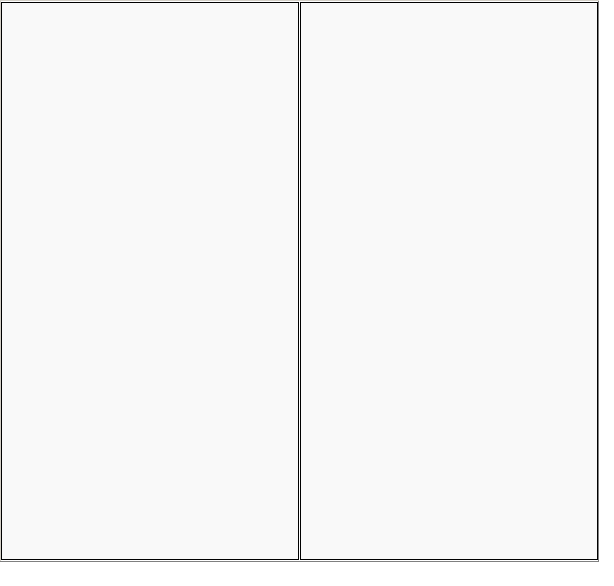 Коробка
подач с накидным 5. Reversing mechanisms зубчатым
колесом 6. Feed gearbox with tumbler gear
Коробка
подач с накидным 5. Reversing mechanisms зубчатым
колесом 6. Feed gearbox with tumbler gear
Суппорт Carriage
7. Суппорт токарно- 7. Engine lathe carriage винторезного станка General information about cutting
Общие сведения о процессе process резания
Учебное пособие обеспечивает студентов текстовым, лексическим материалом по теме «Станки». Оно состоит из 6 уроков. Каждый урок вводит новую лексику по теме. Семантизация слов, специальных терминов и словосочетаний осуществляется многократным называнием слова изолированно и в контекстуальносвязанном словосочетании или предложении. Все задания урока построены по принципу «от простого к сложному» и органически связаны между собой. Также соблюдается принцип повторяемости лексики от задания к заданию, что является одним из основных условий запоминания слов, словосочетаний и специальных терминов.
В основе каждого урока лежит текст. Тематика текстов следующая: «Элементы машин», «Станки», «Токарный станок», «Фрезерный станок», «Сверление», «Шлифовальный станок ». Данная тематика соответствует тематике текстов базового учебника «Английский язык для технических ВУЗов» И.П. Агабекяна. Тексты составлены так, что они объясняют в доступной форме основные металлообрабатывающие процессы, раскрывают понятие «станок», устройство и назначение определенного станка, соответствуют программам специальных предметов. Каждый текст сопровождается рядом упражнений, рассчитанных на активизацию лексического и грамматического материала. Задания направлены на обучение различным приемам оперирования с текстом на всех этапах работы, и их выполнение позволяет студентам овладеть навыками и умениями самостоятельной работы с текстом и подготовиться к речевым высказываниям. Грамматические упражнения построены на знакомом, изученном грамматическом материале и предназначены для повторения данного материала и выполняются в письменной форме. Для совершенствования навыков перевода учебное пособие предлагает упражнения по переводу с русского языка на английский язык, с английского языка на русский, которые выполняются письменно.
При составлении учебного пособия были использованы адаптированные учебные материалы и аутентичные учебные пособия (электронная энциклопедия Encarta Encyclopedia).
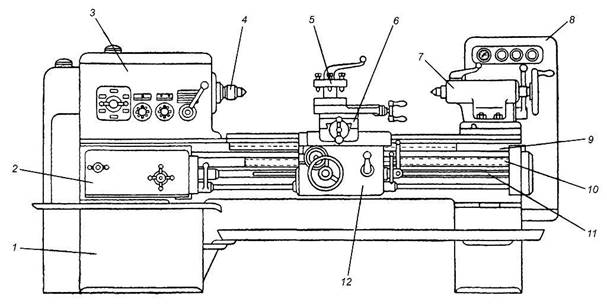
Рис. 1. Общий вид токарно-винторезного станка || Fig. 1. General view of an Engine/Screw-cutting lathe
|
№ |
Термин (Русский) |
Перевод (Английский) |
|
1 |
Тумба |
Leg |
|
2 |
Коробка подач |
Feed gearbox; Change gearbox |
|
3 |
Передняя бабка с коробкой скоростей |
Headstock with speed gearbox |
|
4 |
Шпиндель |
Spindle |
|
5 |
Резцовая головка |
Tool post |
|
6 |
Суппорт |
Carriage |
|
7 |
Задняя бабка |
Tailstock |
|
8 |
Шкаф с электрооборудованием |
Electrical cabinet |
|
9 |
Станина |
Bed |
|
10 |
Ходовой винт |
Lead screw |
|
11 |
Ходовой вал |
Feed rod |
|
12 |
Фартук |
Apron |

Рис. 2. Станина токарного станка || Fig. 2. Lathe bed
|
№ |
Термин (Русский) |
Перевод (Английский) |
|
1 |
Продольная стенка |
Longitudinal wall |
|
2 |
Призматическая направляющая |
Vi guide; V-guide |
|
3 |
Плоская направляющая |
Flat guide |
|
4 |
Конец станицы |
Bed end |
|
5 |
Поперечное ребро жесткости |
Transverse stiffener |
|
6 |
Плоская направляющая |
Flat guide |
|
7 |
Призматическая направляющая |
Vi guide; V-guide |
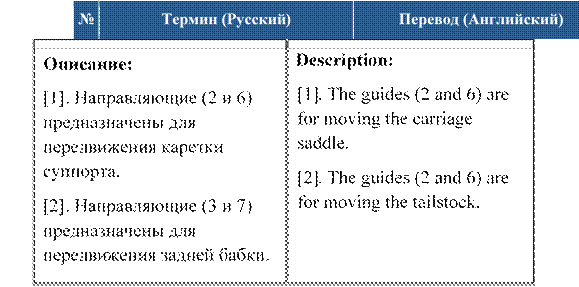
3. Передняя бабка
3. Headstock
|
Назначение: [1]. Передняя бабка служит для закрепления обрабатываемой детали и передачи ей главного движения станка - вращения. [2]. Коробка скоростей - это совокупность валов, зубчатых колес и муфт в передней бабке, при помощи которых вращательное движение вала электродвигателя преобразуется в необходимое по скорости и направлению вращение шпинделя. |
Purpose: [1]. A headstock is used to hold a workpiece and transmit the lathe main motion (rotation) to it. [2]. A speed gearbox is a set of shafts, gears and clutches in the headstock which convert the rotational motion from motor shaft to spindle with a required rotation speed and direction. |

Рис. 3. Шестискоростная коробка скоростей в передней бабке
|| Fig. 3. Six-speed gearbox in headstock
|
№ |
Термин (Русский) |
Перевод (Английский) |
|
1 |
Электродвигатель |
Electric motor |
|
2 |
Приводной шкив |
Driving pulley |
|
3 |
Муфта включения |
Clutch (not Coupling) |
|
4 |
Промежуточное зубчатое колесо |
Intermediate gear |
|
5 |
Входной вал |
Input shaft |
|
6 |
Промежуточный вал |
Intermediate shaft |
|
7 |
Ведущее зубчатое колесо |
Drive gear |
|
8 |
Шпиндель |
Spindle |
|
9 |
Двусторонняя зубчатая муфта |
Double gear clutch |
|
10 |
Ведомое зубчатое колесо |
Driven gear |
|
11 |
Рукоятка для перемещения зубчатых колес (7) |
Handle for moving the gears (7) |
|
12 |
Рукоятка для перемещения муфты (12) |
Handle for moving the clutch (12) |
|
13 |
Кулачковый патрон |
Jaw chuck |
|
14 |
Гитара подач со сменными зубчатыми колесами |
Change gear quadrant |
|
|
|
|
№ Термин (Русский) Перевод
(Английский)
Описание: Description:
[1]. Электродвигатель (1) передает [1]. Electric motor (1) transmits rotation вращение входному валу (5) с постоянным to the input shaft (5) at a constant speed.
числом оборотов. [2]. The gears (7) on the shaft (5) form
[2]. Зубчатые колеса (7) на валу (5) a gear cluster. The gear cluster (7) can составляют блок зубчатых колес. Данный be moved along the shaft (5) by means блок может перемещается вдоль вала (5) с of the handle (11).
помощью рукоятки (11). [3]. The input shaft (5) transmits
 [3]. Входной вал (5)
передает вращение rotation to the intermediate shaft (6) промежуточному
валу (6) при зацеплении when the gear cluster (7) engages with блока
зубчатых колес (7) с одним из one of the intermediate gears (4) on the
промежуточных зубчатых колес (4) на shaft (6). In this case the shaft (6)
валу (6). При этом, вал (6) получает три receives three different
speeds.
[3]. Входной вал (5)
передает вращение rotation to the intermediate shaft (6) промежуточному
валу (6) при зацеплении when the gear cluster (7) engages with блока
зубчатых колес (7) с одним из one of the intermediate gears (4) on the
промежуточных зубчатых колес (4) на shaft (6). In this case the shaft (6)
валу (6). При этом, вал (6) получает три receives three different
speeds.
различные скорости. [4]. The intermediate shaft (6) transmits
[4]. Промежуточный вал (6) передает rotation to one of the gears (10).
вращение одному из зубчатых колес (10). [5]. The left or right gears (10) transmit
[5]. Левое или правое зубчатое колесо (10) rotation to the clutch (9) at different передают вращение муфте (9) с разными speeds.
скоростями. [6]. The clutch (9) postion can be
[6]. Положение муфты (9) можно менять с changed by using the handle (12), помощью рукоятки (12), перемещая ее по moving it along the key of the splindle шпонке шпинделя (8). (8).
[7]. Муфта (9) передает вращающий [7]. The clutch (9) transmits torque момент от зубчатых колес (10) шпинделю from the gears (10) to the spindle (8).
(8).
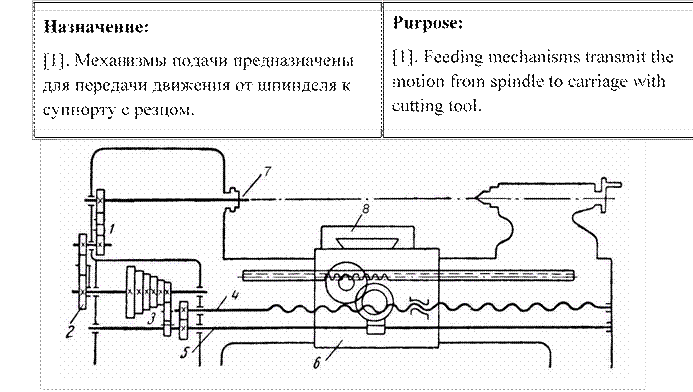
|
№ |
Термин (Русский) |
Перевод (Английский) |
|
1 |
Реверсирующий механизм |
Reversing mechanism |
|
2 |
Гитара подач со сменными зубчатыми колесами |
Change gear quadrant |
|
3 |
Коробка подач |
Feed gearbox; Change gearbox |
|
4 |
Ходовой винт |
Lead screw |
|
№ |
Термин (Русский) |
Перевод (Английский) |
|
5 |
Ходовой вал |
Feed rod |
|
6 |
Фартук |
Apron |
|
Назначение: [1]. Реверсирующие механизмы предназначены для изменения вращательных и прямолинейных движений узлов станка (например, ходового винта, ходового вала и т.д.). |
Purpose: [1]. Reversing mechanisms change the direction of rotational and linear motions of machine parts (for example, lead screw, feed rod, etc.). |
|
|
|
5. Реверсирующие механизмы
5. Reversing mechanisms
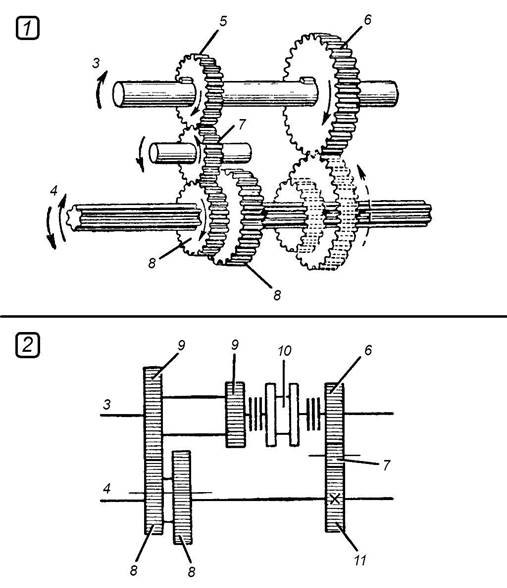
Рис. 5. Реверсирующие механизмы || Fig. 5. Reversing mechanisms
|
№ |
Термин (Русский) |
Перевод (Английский) |
|
1 |
Реверсирующие механизмы с передвижными цилиндрическими зубчатыми колесами |
Reversing mechanisms with sliding cylindrical gears |
|
2 |
Реверсирующие механизмы с цилиндрическими зубчатыми колесами, |
Reversing mechanisms with cylindrical gears |
|
№ |
Термин (Русский) |
Перевод (Английский) |
|
||
|
|
включаемыми посредством пластинчатой фрикционной муфты |
engaged by a plate friction clutch |
|||
|
3 |
Ведущий вал |
Drive shaft |
|||
|
4 |
Ведомый вал |
Driven shaft |
|||
|
5 |
Ведущее зубчатое колесо прямого хода |
Forward drive gear |
|||
|
6 |
Ведущее зубчатое колесо обратного хода |
Reverse drive gear |
|||
|
7 |
Паразитное колесо |
Idle gear; Intermediate gear |
|||
|
8 |
Ведомый двухвенцовый блок |
Driven double gear |
|||
|
9 |
Ведущий двухвенцовый блок прямого хода |
Forward drive double gear |
|||
|
10 |
Пластинчатая фрикционная муфта |
Plate friction clutch |
|||
|
11 |
Ведомое зубчатое колесо |
Driven gear |
|||
|
|
|
|
|||
|
|
Описание: [1]. Ведомый двухвенцовый блок (8) может перемещаться по шлицам ведомого вала (4) и передавать ему прямое или обратное вращение в зависимости от сопряжения с зубчатым |
Description: [1]. The driven double gear (8) can move along the driven shaft (4) splines and transmit a forward or reverse rotation to it, depending on conjunction with the gear (5) or (6). [2]. The clutch (10) can engage the forward |
|||
 |
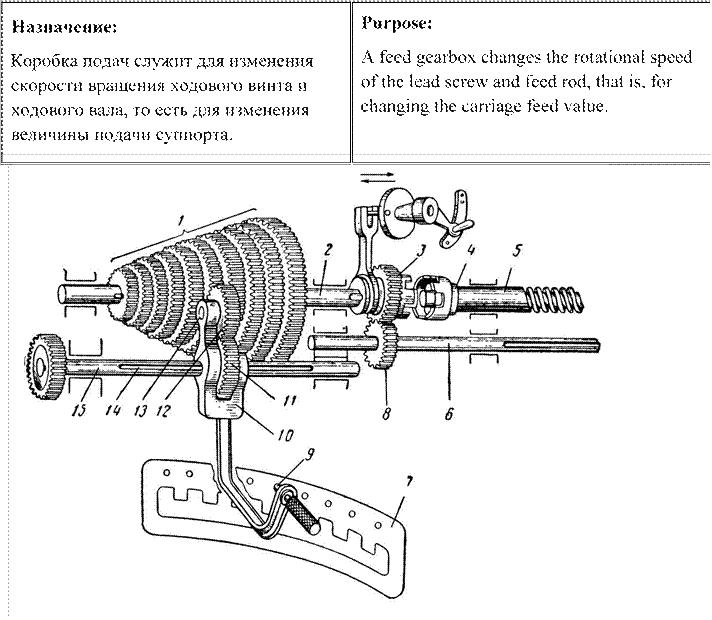 |
Рис. 6. Коробка подач с накидным зубчатым колесом || Fig. 6. Feed gearbox with tumbler gear
|
№ |
Термин (Русский) |
Перевод (Английский) |
|
1 |
Ступенчатый конус зубчатых колес |
Gear cone; Cone of gears |
|
2 |
Ведомый валик коробки подач |
Driven shaft of the gearbox |
|
3 |
Передвижное зубчатое колесо с кулачками |
Sliding gear with dogs |
|
4 |
Кулачковая муфта |
Dog clutch |
|
5 |
Ходовой винт |
Lead screw |
|
6 |
Ходовой вал |
Feed rod |
|
7 |
Передняя стенка коробки подач |
Front panel of the gearbox |
|
8 |
Зубчатое колесо ходового вала |
Feed rod gear |
|
9 |
Штифт |
Pin |
|
10 |
Рычаг |
Lever |
|
11 |
Зубчатое колесо ведущего валика коробки подач |
Drive shaft gear |
|
12 |
Накидное зубчатое колесо |
Tumbler gear |
|
13 |
Ось накидного колеса |
Tumbler gear axis |
|
14 |
Шпоночный паз |
Keyway |
|
15 |
Ведущий валик коробки подач |
Drive shaft of the gearbox |
7. Суппорт токарно-винторезного станка
|
Описание: [1] Ведущий валик (15) получает вращение от сменных зубчатых колес гитары. [2] Зубчатые колеса (11) и (12) можно перемещать вдоль валика (15) посредством рычага (10). [3] Ведомый валик (2) получает различные скорости вращения в зависимости от положения рычага (10). [4] Зубчатое колесо (3) на ведомом валике (2) может передавать вращающий момент ходовому винту (5) или ходовому валу (6) с разными скоростями. |
Description: [1] The drive shaft (15) is rotated by the change gears of the quadrant. [2] The gears (11) and (12) can be moved along the shaft (15) by means of the lever (10). [3] The driven shaft (2) has different rotational speeds depending on the lever (10) position. [4] The gear (2) on the driven shaft (3) can transmit torque to the lead screw (5) or feed rod (6) at different speeds. |
|
|
|
7. Engine lathe carriage
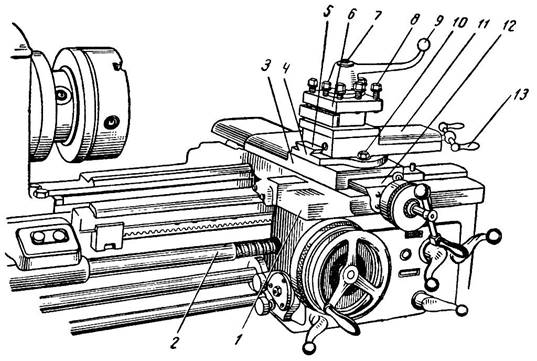
|
№ |
Термин (Русский) |
Перевод (Английский) |
|
1 |
Каретка суппорта; Продольные салазки суппорта |
Carriage saddle; Longitudinal slide |
|
2 |
Ходовой винт |
Lead screw |
|
3 |
Поперечные салазки суппорта |
Cross slide |
|
4 |
Поворотная плита верхних салазок суппорта; Поворотная плита верхнего суппорта |
Swivel base for top slide; Swivel base for compound rest |
|
5 |
Направляющие верхних салазок суппорта; Направляющие верхнего суппорта |
Slideways for top slide; Compound rest guideways |
|
6 |
Четырехгранная резцовая головка для закрепления четырех резцов или резцедержателей |
Four-sided tool post for holding four tool bits or tool holders |
|
7 |
Винт для закрепления резцовой головки |
Tool post screw |
|
8 |
Винт для закрепления резца |
Tool bit screw |
|
9 |
Рукоятка крепления резцовой головки |
Tool post locking handle |
|
10 |
Винтовая гайка |
Screw nut |
|
11 |
Верхняя часть суппорта |
Top part of the carriage; Top slide; Compound rest |
|
12 |
Направляющие |
Guideways |
|
13 |
Рукоятка перемещения верхних салазок |
Top slide handle; Compound rest handle |
8. Резцедержатели
|
Назначение: [1]. Закрепление резцов. |
Purpose: [1]. For holding tool bits. |
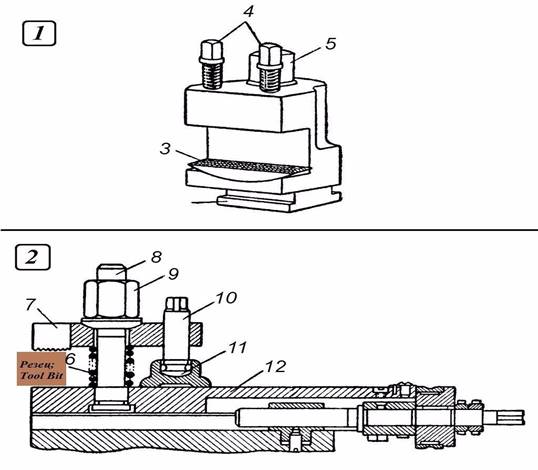
|
№ |
Термин (Русский) |
Перевод (Английский) |
|
1 |
Одноместный резцедержатель для мелких и средних станков |
One seat holder for small- and medium-sized lathes |
|
2 |
Одноместный резцедержатель для крупных станков |
One seat holder for large-sized lathes |

|
№ |
Термин (Русский) |
Перевод (Английский) |
|
1 |
Ходовой вал |
Feed rod |
|
2 |
Шпоночная канавка ходового вала |
Feed rod keyway |
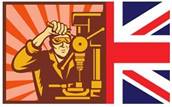 PRACTICAL PART:
PRACTICAL PART:
LESSON 1. MACHINE ELEMENTS
Задание 1:Переведите данные ниже слова и словосочетания на русский язык:
Machine__________, device_________, to perform_________, activity__________, usage__________, part__________, to assist_________, to transform___________, direction__________, magnitude__________, force_________, to consume_________, to derive__________, expedient__________, remedy_________, wedge____________, pulley__________, levers_________, machine tool________, join________, to achieve_________, shaft_______, to rotate_________, motion___________, to mount_________, bearing________, to reduce___________, to require___________, to couple_________.
Задание 2:Подберите соответствующие русские эквиваленты английским словам из задания 1:
Употребление___________, целесообразный___________, средство_________, устройство__________, часть__________, выполнять___________, передавать__________, сила_________,. Механизм___________, происходить__________, действие_________, потреблять___________, клин________, помогать_______, рычаг________, величина__________, направление_________, соединять__________, достигать__________, шкив_______, станок______, сварка__________, вал_________, вращать________, движение__________, устанавливать__________, подшипник________, уменьшать_________, требовать__________, соединять___________.
Задание З:Переведите на русский язык следующие словосочетания:
• to perform some activity to assist in performing any type of work_______________________ ___________________________
___________________________
• to transform the direction or magnitude of a force instruments consisting of many elements ___________________________ ___________________________ ___________________________
___________________________
• to joined into one piece by welding_____________________
___________________________
• to be done by either gas welding or electric welding
___________________________
___________________________
• to be achieved by means of nuts and bolts to make this motion possible_____________________ ___________________________
___________________________
• to reduce friction
_________________________
• to require less lubrication
___________________________
• to engage and disengage
___________________________
• to be mounted on shafts by means of keys.
___________________________
___________________________
Задание 4:Переведите на русский язык следующий текст:
Machine elements.
A machine is any device that uses energy to perform some activity. In common usage, the meaning is that of a device having parts that perform or assist in performing any type of work. A simple machine is a device that transforms the direction or magnitude of a force without consuming any energy.
The word "machine" is derived from the Latin word “machine”, which means, expedient, remedy". It may be anything from such an elementary machine as a wedge or a lever to a steam turbine. In practice such simple machines as levers, wedges or pulleys are not spoken of as machines. This name is used for instruments consisting of many elements.
There is, of course, an enormous number of different machines, such as printing machines, machine tools, sewing machines, combustion engines, refrigerators, etc. Although each of this consists of different parts and elements, there are some machine elements that are common to most machines.
Every machine has a frame on which the other parts are mounted and the method of joining these parts to each other is more or less the same in all machines. Two pieces of metal can be joined into one piece by welding them together, which is done by either gas welding or electric welding. A bolted joint is achieved by means of nuts and bolts. A bolt consists of the head and the shank with the thread.
Many parts of a machine are mobile. A shaft, for instance, rotates about its axis, and in order to make this motion possible, it is mounted in bearings. Ball bearings and rolled bearings are, of course, preferable, since they reduce friction and require less lubrication. If we want to connect two shafts together, we couple them. Some well known couplings are flange coupling and the sleeve or muff. If the two shafts are not permanently coupled to each other, but can be made to engage and disengage, the coupling is called a clutch. Jaw clutches are widely used, but friction clutches are also used where the shafts require to be connected while running. Wheels are mounted on shafts by means of keys.
Задание 5:Ответьте на вопросы к тексту:
• What is a machine?____________________________________________________
• What simple machines do you know?______________________________________
• What is the main part of every machine?____________________________________
• How can be joined two pieces of metal?____________________________________ What parts does a bolt consist of?_________________________________________
• What couplings do you know?____________________________________________
Задание 6:Заполните пропуски в предложениях в соответствии с содержанием текста:
1. A machine is any device that__________________________________________ .
2. A machine performs any ._____________________________________________
3. Elementary machines are._____________________________________________
4. Every machine has .______________________________________________
5. Many parts of a machine are .________________________________________
6. Ball bearings reduce friction and ._____________________________________
Задание 7: Поставьте глаголы, данные в скобках в правильную форму:
1. A simple machine (to transform)___________ the direction or magnitude of a force.
2. A simple machine (not to consume)____________ any energy.
3. A wedge (to be)_________ a simple machine.
4. Instruments (to consist)___________ of many elements.
5. A bolt (to consist)____________ of the head and the shank with the thread.
6. A shaft (to rotate)________________ about its axis.
7.
Задание 8:
Переведите следующие предложения на английский язык: 1. Чтобы выполнить действие механизм использует энергию .______________________________________________________________ 2. Рычаги и шкивы не называют механизмами.
_______________________________________________________________ 3. Любой механизм состоит из многих частей и элементов.
_______________________________________________________________ 4. Некоторые механические элементы общие для большинства механизмов.
_______________________________________________________________
Задание 9.
Переведите следующие предложения на русский язык:
1. If we want to connect two shafts together, we couple them.
_______________________________________________________________
2. If the two shafts are not permanently coupled to each other, but can be made to engage and disengage, the coupling is called a clutch.
_______________________________________________________________
Задание 10.
Составьте из данных слов предложение, соблюдая порядок слов:
1. a device, parts, that, means, any type of work, a machine, having, perform.
_______________________________________________________________
2. many elements, of, "machine", for instruments, is, the name, consisting, used.
_______________________________________________________________
3. rotating, mounted, a shaft, about its axis, in bearings , is.
_______________________________________________________________ 4. is, a device, the direction, a simple machine, transforming, of a force.
________________________________________________________________
LESSON 2. MACHINE-TOOLS
Задание 1:
Переведите данные ниже слова и словосочетания на русский язык: to undergo____________, trimming____________, spinning____________, to provide____________, groove____________, thread____________, source____________, lathe____________, cutting tool____________, headstock____________, chuck____________, tailstock____________, bed____________. to adjust____________, carriage____________, saddle___________, tool holder____________, turret lathe____________, broaching machine________________________,
Задание 2:
Подберите соответствующие русские эквиваленты английским словам:
|
chuck, tailstock, bed, to adjust, carriage, saddle. tool holder, turret lathe, broaching machine, to undergo, trimming, spinning, to provide, groove, thread, source, lathe, cutting tool, headstock, |
обрезка, патрон, обеспечивать, резцедержатель, подвергать, режущий инструмент, передняя бабка, канавка, регулировать, резьба, задняя бабка, салазки, кручение, протяжной станок, револьверный - станок, станина, суппорт, источник, токарный станок |
|
________________________
|
________________________ |
Задание З: Переведите на русский язык следующие словосочетания:
• to be formed into the required shape
____________________________________
• to use a power source other than human movement
_______________________________________________
• found in almost any workshop
________________________________________________
• a perfection of the ordinary lathe
________________________________________________
• to make non-circular holes
• ____________________________________
Задание 4: Прочитайте текст, поймите его содержание, выполните задания после текста.
MACHINE-TOOLS
Before metal is formed into the required shape, it has to undergo a number of processes, such as casting, rolling, forging, welding, piercing, trimming, spinning, bending, drawing, etc. The machines which work on the surface of the metal piece, or provide it with grooves or holes or with a thread are called machine-tools.
The term machine tool is usually reserved for tools that used a power source other than human movement. The first machine tools offered for sale were constructed by Matthew Murray in England around 1800.
The most common machine-tool found in almost any workshop is the lathe, in which the job spins round its axis while a cutting tool is working on it. Its main parts are: the headstock, the chuck, the tailstock, the lathe bed, the carriage. The headstock usually contains the gearing mechanism. The job is clamped into the chuck. The tailstock can be moved along the bed to adjust the distance between the chuck and the tailstock centre. The carriage consists of the saddle and the cross slide on which the tool holder with the tool is mounted.
The speed at which the lathe turns can be adjusted either by regulating the speed of the motor driving it, or by the gearing. The automatic turret lathe is a perfection of the ordinary lathe. Its tools are changed automatically. A worker skilled in the use of a lathe is called a turner.
Other machine-tools work on plane surfaces for example milling machines, and also planning and shaping machines. A broaching machine employs broaches to make non-circular holes. Circular holes are drilled by a drilling machine or bored by a boring machine or a boring mill. Gear cutting machines include gear milling machines, gear shapers and gear grinding machines. Thread milling machines are used in the production of threads on shafts and on other machine elements.
All these machines use cutting tools, usually made of high-speed steel; grinding machines, on the other hand use abrasives such as diamonds, diamond dust, corundum, silicon carbide, etc. Honing and lapping machines also use abrasives; they enable us to obtain a smooth finish of less than 001 mm.
Задание 5:
Ответьте на вопросы к тексту:
1.What machines are called machine tools? ___________________________
2.When was constructed the first machine tool? ___________________________
3.What is the most common machine tool? ___________________________
4.What are the main parts of the lathe? ___________________________ 5.What other machine tools do you know? ___________________________
6.What machine tools are used for making circular holes?
______________________________________________________
Задание 6:
Заполните пропуски в предложениях в соответствии с содержанием текста:
1.The machine tools provide the surface of the metal piece with ____________.
2.The job in the lathe spins round . ___________________________
3.The tailstock can be moved . ___________________________
4.The tool holder is mounted on . ___________________________
Задание 7:
Поставьте глаголы, данные в скобках в правильную форму:
1.Look! The machine tool (to work) ____________ on the surface of the metal piece.
2.The first machine tools (to build) ____________ in England in 1800.
3.The most common machine tools (to find) ____________ in almost any workshop.
4.The job (to clamp) ____________ into the chuck.
5.The tailstock (to adjust) ____________ the distance between the chuck and the tailstock.
6.The carriage (to consist) ____________ of the saddle and the cross slide.
Задание 8: Переведите следующие предложения на русский язык:
1.Before metal is formed into the required shape, it has to undergo a number of processes, such as casting, rolling, forging, welding, piercing, trimming, spinning, bending, drawing, etc. ______________________________________________ __________________________________________________________________
_________________________________________________________________
2.All these machines use cutting tools, usually made of high-speed steel; grinding machines, on the other hand use abrasives such as diamonds, diamond dust, corundum, silicon carbide, etc. ________________________________________ __________________________________________________________________
__________________________________________________________________
3.The speed at which the lathe turns can be adjusted either by regulating the speed of the motor driving it, or by the gearing. _________________________________ __________________________________________________________________ 4.Thread milling machines are used in the production of threads on shafts and on other machine elements. ______________________________________________ __________________________________________________________________
5.The tools are changed automatically.___________________________________ 6.A worker skilled in the use of a lathe is called a turner.
__________________________________________________________________ LESSON 3.LATHE
Задание 1:
Переведите данные ниже слова и словосочетания на русский язык:
То apply____________, work piece____________, to create____________, to shape____________, pottery____________, to accommodate____________, incredible____________, rotation____________, precision____________, craftsmen____________, wobbling____________,
three-jaw universal chuck____________, four-jaw independent chuck____________ , to be aligned____________, Задание 2:
Подберите соответствующие русские эквиваленты английским словам:
|
precision, craftsmen, wobbling, three-jaw universal chuck, four-jaw independent chuck, to be aligned, to apply, work piece, to create, to shape, pottery, to accommodate, incredible, rotation,
|
трехкулачковыи универсальный патрон, формировать, четырехкулачковый независимый патрон, керамика, применять, расшатывание, специалисты, сопровождать, невероятный, вращение, точность, быть отрегулированным, заготовка, создавать |
|
|
|
Задание З: Переведите на русский язык следующие словосочетания:
• to spin a block of material____________________________________
• to have symmetry about an axis of rotation________________________________________________
• to shape pottery____________________________________
• to produce plane surfaces and screw threads to be created in less time_____________________________________________________
• can be created with accurate precision____________________________________
• to be fastened at opposite ends____________________________________
• carriage and tailstock slide____________________________________
• to rotate without wobbling while turning____________________________________
• to run the lathe at various speeds. ________________________ the axes of both centers must be on one line.
____________________________________
• may be tested by taking a cut and then measuring both ends of the cut with a micrometer, ____________________________________
• may be turned without using the dead center
________________________________________________
Задание 4:
Прочитайте текст, поймите его содержание, выполните задания после текста.
LATHE
A lathe is a machine tool which spins a block of material to perform various operations such as cutting, sanding, drilling, or deformation with tools that are applied to the work piece to create an object which has symmetry about an axis of rotation.
Lathes are used in woodturning, metalworking, metal spinning, and glass working. Lathes can be used to shape pottery, the best-known design being the potter's wheel. Most suitably equipped metalworking lathes can also be used to produce plane surfaces and screw threads.
The lathe is an ancient tool; it was first developed by the Egyptians around 1300 BC. During the industrial revolution the lathe was motorized, allowing wooden turned items to be created in less time and allowing the working of metal on a lathe. The motor produced a greater rotational speed, makes it easier to quickly produce high quality work. Today most lathes are computer operated allowing for mass-production that can be created with accurate precision and without the cost of employing craftsmen.
The largest part of the lathe is called the bed on which the headstock and the tailstock are fastened at opposite ends. On the upper part of the bed there are special ways upon which the carriage and tailstock slide.
The two lathe centers are mounted in two spindles: one (the live center) is held in the headstock spindle while the other (the dead center) - in the tail- stock spindle.
The lathe chuck is used for chucking the work that is for clamping it so that it will rotate without wobbling while turning. The chucks usually mounted on the headstock spindle, may have different size and constructions.
If the work is perfectly round, it may be chucked in the so-called threejaw universal chuck all the jaws of which are moved to the center by turning the screw. But if the work is not perfectly round, the four-jaw independent chuck should be used.
In turning different materials and works of different diameter, lathes must be run at different speeds. The gear box contained in the headstock makes it possible to run the lathe at various speeds.
Before turning a work in the lathe, the lathe centers are to be aligned, that means that the axes of both centers must be on one line.
The alignment of the lathe centers may be tested by taking a cut and then measuring both ends of the cut with a micrometer.
Not all works should be fastened between the two centers of the lathe. A short work may be turned without using the dead center, by simply chucking it properly at the spindle of the head- stock.
Задание 5:
Ответьте на вопросы к тексту:
1.What machine tool is the lathe?
________________________________________________ 2.What operations can the lathe perform?
________________________________________________ 3.When was the first lathe constructed?
________________________________________________
4. What is the largest part of the lathe?
________________________________________________ 5.What is the lathe chuck used for? Where is it mounted? ________________________________________________ 6.How many work centers are there on the lathe? ________________________________________________ 7.Where is the dead center mounted?
________________________________________________ 8.How many spindles are there on a lathe?
_________________________________________________
9.What two general kinds of chucks are used for clamping the work that has to be turned on a lathe?
________________________________________________ 10. What mechanism changes the speeds the lathe is run at?
________________________________________________
Задание 6:
Заполните пропуски в предложениях в соответствии с содержанием текста:
1.The largest part of the lathe is called . ________________________
2.The headstock and the tailstock are fastened at . _________________
3.The lathe chucks may have different . ________________________
4.The short work may be turned without . ________________________
Задание 7:
Поставьте глаголы, данные в скобках в правильную форму:
1.The lathe (to perform) many operations. ________________________
2.Almost all lathes (to have) a bed. ________________________
3.The headstock (to contain) a spindle. ________________________ 4.A work piece (to be clamped) in a three- or four-jaw chuck, which (to mount) directly to the spindle. ____________________________________ 5.In a metalworking lathe, metal (to be removed) from the work piece using a hardened cutting tool. ____________________________________ 6.Cutting tools (to come) in a wide range of sizes and shapes.
____________________________________
Задание 8:
Переведите следующие предложения на русский язык:
1.If the work is perfectly round, it may be chucked in the so-called three-jaw
universal chuck all the jaws of which are moved to the center by turning the screw. ________________________________________________ ______________________________________________________________
__________________________________________________________ 2.If the work is not perfectly round, the four-jaw independent chuck should be used. ________________________________________________ ____________________________________________________________
3.Not all works should be fastened between the two centers of the lathe.
____________________________________________________________
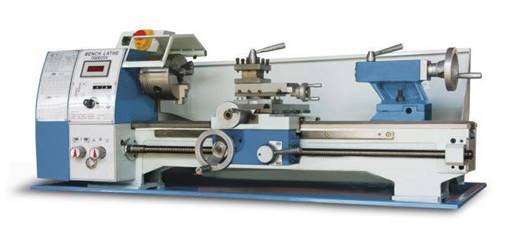
LESSON 4.
MILLING MACHINES
Задание 1:
Переведите данные ниже слова и словосочетания на русский язык: to feed____________, cutter____________, cutting edges____________, to mount____________, to revolve____________, to reciprocate____________, self-contained____________, resting____________, to swing____________, precision____________, arbor____________, knee-type____________, project____________, ride____________, reamer____________, arbor support____________, ramtype____________.
Задание 2:
Подберите соответствующие русские эквиваленты английским словам:
|
То swing, precision, arbor, knee-type, project, ride, to feed, cutter, cutting edges, to mount, to revolve, to reciprocate, selfcontained, resting, reamer,arbor support, ram-type |
шпиндель, опора, поворачиваться, консольный, подавать, независимый, двигаться взад и вперёд, фреза, точность, вращаться, устанавливать, выдвигаться, режущие края, двигаться, развёртка, кронштейн, широкоуниверсальный |
|
|
|
Задание З:
Переведите на русский язык следующие словосочетания:
• machining flat, curved, or irregular surfaces feeding the work piece
________________________________________________
• against a rotating cutter containing a number of cutting edges
________________________________________________
• to mount and revolve the milling cutter
________________________________________________
• to reciprocate adjustable worktable, which mounts and feeds the work piece. _____________________________________________________
• to have self-contained electric drive motor
________________________________________________
• a massive casting ____________________________________
• to be properly adjusted vertically for operation can be fed up and down by hand or power ____________________________________ __________________________________________________________
• can swivel to permit working on angular surfaces to contain one or more arbor supports ____________________________________
__________________________________________________________
• to project forward from the top of the column ____________
________________________________________________
• to be desired depending on the position of the milling cutter or cutters
__________________________________________________________
• to ride up or down the column on a rigid track
____________ ____________ ____________ ____________
Задание 4:
Прочитайте текст, поймите его содержание, выполните задания после текста.
MILLING MACHINES
Milling is the process of machining flat, curved, or irregular surfaces by feeding the work piece against a rotating cutter containing a number of cutting edges. The usual Mill consists basically of a motor driven spindle, which mounts and revolves the milling cutter, and a reciprocating adjustable worktable, which mounts and feeds the work piece.
Milling machines are basically classified as vertical or horizontal. These machines are also classified as knee-type, ram-type, manufacturing or bed type, and planer-type. Most milling machines have self-contained electric drive motors, coolant systems, variable spindle speeds, and power-operated table feeds.
TYPES OF MILLING MACHINES KNEE-TYPE
Knee-type mills are characterized by a vertically adjustable worktable resting on a saddle which is supported by a knee. The knee is a massive casting that rides vertically on the milling machine column and can be clamped rigidly to the column in a position where the milling head and milling machine spindle are properly adjusted vertically for operation.
The plain vertical machines are characterized by a spindle located vertically, parallel to the column face, and mounted in a sliding head that can be fed up and down by hand or power. Modern vertical milling machines are designed so the entire head can also swivel to permit working on angular surfaces. The turret and swivel head assembly is designed for making precision cuts and can be swung 360° on its base. Angular cuts to the horizontal plane may be made with precision by setting the head at any required angle within a 180° arc.
The plain horizontal milling machine's column contains the drive motor and gearing and a fixed position horizontal milling machine spindle. An adjustable overhead arm containing one or more arbor supports projects forward from the top of the column. The arm and arbor supports are used to stabilize long arbors. Supports can be moved along the overhead arm to support the arbor where support is desired depending on the position of the milling cutter or cutters.
The milling machine's knee rides up or down the column on a rigid track. The milling machine is excellent for forming flat surfaces, forming and fluting milling cutters and reamers, cutting gears. Many special operations can be performed with the attachments available for milling machine use. The knee is used for raising and lowering. The saddle rests upon the knee and supports the worktable. The saddle controls cross feed of the worktable. The worktable traverses to the right or left upon the saddle for feeding the work piece past the milling cutter. The table may be manually controlled or power fed. Задание 5: Ответьте на вопросы к тексту:
1.What process is called milling?
____________________________________
2.What main parts does the milling machine consist of?
____________________________________ 3.How are milling machines classified? ____________________________________
4.What part is called knee?
________________________________________________ 5.What is the knee used for?
________________________________________________
Задание 6: Поставьте глаголы, данные в скобках в правильную форму:
1.A rotating cutter (to contain) ____________ __ a number of cutting edges. 2.A spindle (to mount) ____________ and (to revolve) ____________ the milling cutter.
3.The milling cutter (not to revolve) ____________ a spindle.
4.The milling machine (to use) ____________ for forming flat surfaces, forming and fluting milling cutters.
5.A spindle (to locate) ____________ vertically, parallel to the column face. 6.The entire (to swivel) ____________ to permit working on angular surfaces.
Задание 7:
Переведите на русский язык следующий текст: SAFETY RULES FOR MILLING MACHINES
Milling machines require special safety precautions while being used.
Do not make contact with the revolving cutter.
Place a wooden pad or suitable cover over the table surface to protect it from possible damage.
Use the buddy system when moving heavy attachments.
Do not attempt to tighten arbor nuts using machine power.
When installing or removing milling cutters, always hold them with a rag to prevent cutting your hands.
While setting up work, install the cutter last to avoid being cut.
Never adjust the work piece or work mounting devices when the machine is operating.
Chips should be removed from the work piece with an appropriate rake and a brush.
NOTE Chip rake should be fabricated to the size of the T-slots.
Shut the machine off before making any adjustments or measurements.
When using cutting oil, prevent splashing by using appropriate splash guards. Cutting oil on the floor can cause a slippery condition that could result in operator injury
pad – подкладка to splash - брызгать to tighten – затянуть rag - тряпка
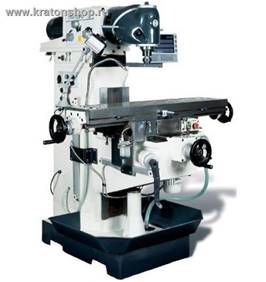
LESSON 5.
DRILLING
Задание 1:
Переведите данные ниже слова и словосочетания на русский язык: a drill bit____________. to enlarge a hole____________, multipoint____________, torque____________ , to be gripped____________, tip____________, offset____________, pillar____________, to restrain____________, advantage____________, invention____________, power sources____________, workbench____________, a rack____________, effort____________, to cut____________
Задание 2:
Подберите соответствующие русские эквиваленты английским словам:
|
a drill bit, to enlarge a hole, multipoint, torque , to be gripped, tip, offset, pillar, to restrain, advantage, invention, power sources, work bench, a rack, effort, to cut |
Увеличить отверстие, многоточечный, вращающий момент, захватываться, наконечник, отклонённый, опора, ограничить, сверло, преимущество, изобретение, источники энергии, верстак, зубчатая рейка, усилие, резать |
|
|
|
ЗаданиеЗ:Переведите на русский язык следующие словосочетания:
• to cut or enlarge a hole in solid materials________________________
• by applying pressure and rotation to the work piece to create cylindrical holes ____________________________________________________________
• to provide torque and axial force ____________________________________
• to be gripped by a chuck at one end of the drill
____________________________________________________________
• to be pressed against the target material
__________________________________________________________________
• to be powered by various power sources over the centuries
____________________________________________________________
• to be mounted on a stand or bolted to the floor to have a number of advantages
____________________________________________________________
• to apply the drill to the work piece
________________________________________________
Задание 4: Найдите в тексте английские эквиваленты следующим русским словосочетаниям:
• многоточечный, концевой режущий инструмент ________________________
• образует стружки режущими краями____________________________________ образовывать отверстие____________________________________
• отверстия нецилиндрической формы____________________________________
• просверливать отверстия в различных материалах________________________
• наконечник режущего инструмента____________________________________
• можно регулировать____________________________________
• просверливать точно____________________________________
Задание 5:
Прочитайте текст, поймите его содержание, выполните задания
после текста.![]()
DRILLING
Drilling is a cutting process that uses a drill bit to cut or enlarge a hole in solid materials. The drill bit is a multipoint, end cutting tool. It cuts by applying pressure and rotation to the work piece, which forms chips at the cutting edge. Drill bits are cutting tools used to create cylindrical holes. Bits are held in a tool called a drill, which rotates them and provides torque and axial force to create the hole. Specialized bits are also available for non-cylindrical-shaped holes.
A drill or drill motor is a tool fitted with a rotating cutting tool, usually a drill bit, used for drilling holes in various materials. The cutting tool is gripped by a chuck at one end of the drill and rotated while pressed against the target material. The tip of the cutting tool does the work of cutting into the target material.
Drills are commonly used in woodworking, metalworking, and construction and most "do it yourself' projects. Specially designed drills are also used in medicine, space missions and other applications.
The earliest drills were used by the ancient Egyptians. The drill press as a machine tool is many centuries old. It wras powered by various power sources over the centuries, such as human effort, water wheels, and windmills, often with the use of belts. With the coming of the electric motor in the late 19th century, there was a great rush to power machine tools with such motors, and drills were among them. The invention of the first electric drill is credited to Arthur James Arnot and William Blanch Brain, in 1889, at Melbourne, Australia.
There are many types of drills: some powered manually, others using electricity or compressed air as the motive power.
A drill press is a fixed style of drill that may be mounted on a stand or bolted to the floor or workbench. A drill press consists of a base, column, table, spindle, and drill head, usually driven by an induction motor. The head has a set of handles (usually 3) radiating from a central hub that, when turned, move the spindle and chuck vertically, parallel to the axis of the column. The table can be adjusted vertically and is generally moved by a rack and pinion. The table may also be offset from the spindle's axis and in some cases rotated to a position perpendicular to the column.
A drill press has a number of advantages over a hand-held drill:
Less effort is required to apply the drill to the work piece. The movement of the chuck and spindle is by a lever working on a rack and pinion, which gives the operator considerable mechanical advantage.
The table allows a vise or clamp to be used to position and restrain the work, making the operation much more secure.
The angle of the spindle is fixed relative to the table, allowing holes to be drilled accurately.
Задание 6:Ответьте на вопросы к тексту:
1.What is drilling used for? ____________________________________
2. What is a drill bit? ________________________________________________
3.What operations is a drill used in? ____________________________________
4.When was the first electric drill invented? _________________________________ 5.What main parts does a drill press consist of? ________________________
6.What advantages does a drill press have over a hand-held drill?
____________________________________
Задание 7:
Поставьте глаголы, данные в скобках в правильную форму:
1.A drill bit (to cut) ____________ or (to enlarge) ____________ a hole in solid materials.
2.Drill bits (to use) ____________ to create cylindrical holes.
3.A drill bit (to use) ____________ for drilling holes in various materials.
4.A drill press (to consist) ____________ of a base, column, table, spindle, and drill head.
Задание 8:Переведите следующие предложения на русский язык:
1.Bits are held in a tool called a drill, which rotates them and provides torque and axial force to create the hole. ________________________________________________
____________________________________________________________
2.The cutting tool is gripped by a chuck at one end of the drill and rotated while pressed against the target material.
______________________________________________________________________
_______________________________________________________
3.The earliest drills were used by the ancient Egyptians.
________________________________
____________________________________
4.A drill press has a number of advantages over a hand-held drill.
____________________________________
Задание 9:Переведите на русский язык следующий текст:
Drilling.
![]() Drilling means
cutting a hole with a tool called a drill. Drills are made of very hard steel
because the cutting tool must be harder than the material to be cut. A drilling
machine is a machine which holds and turns a drill to cut holes in metal. It
also called a drill press or a driller. The hand driller is common drilling
tool which is used for very light work. It is held with the left hand while the
right hand turns the handle which causes the drill to turn. The left hand must
press hard enough to make the drill cut. Many objects cannot be brought to the
drilling machine so the drill is to be brought to them. A small drilling
machine which can be carried from work to work and which is run by means of a
separate electric motor is called electric driller.
Drilling means
cutting a hole with a tool called a drill. Drills are made of very hard steel
because the cutting tool must be harder than the material to be cut. A drilling
machine is a machine which holds and turns a drill to cut holes in metal. It
also called a drill press or a driller. The hand driller is common drilling
tool which is used for very light work. It is held with the left hand while the
right hand turns the handle which causes the drill to turn. The left hand must
press hard enough to make the drill cut. Many objects cannot be brought to the
drilling machine so the drill is to be brought to them. A small drilling
machine which can be carried from work to work and which is run by means of a
separate electric motor is called electric driller.
The Vertical Spindle Drill Press is the most common drilling machine. It may have different sizes and various constructions. Small drill presses of this group are usually fed only by hand and can be used only for drilling small holes in light work. Large and powerful presses of this group kind have special gears for changing speeds and also the drill may be fed into the work by means of automatic feed. Larger drills can be used in this machine than in the smaller ones.
Материалы на данной страницы взяты из открытых источников либо размещены пользователем в соответствии с договором-офертой сайта. Вы можете сообщить о нарушении.